Introduction
Getting a tattoo is exciting—but for many people, the thought of pain is the biggest hesitation. The truth is, all tattoos hurt at least a little, but not all areas of the body are equally sensitive. Some spots are known to be much more tolerable than others, especially for beginners or anyone nervous about pain.
In this guide, we’ll explore the least painful places to get a tattoo, why certain areas hurt more than others, and what you can do to minimize discomfort before, during, and after your session. You’ll learn how anatomy, skin thickness, and nerve endings affect your pain experience, plus insider tips from tattoo artists and clients alike.
Whether you’re getting your first tattoo or planning your next one, this article will help you pick a placement that feels comfortable, heals well, and still looks amazing. Let’s make your tattoo journey as painless—and enjoyable—as possible.
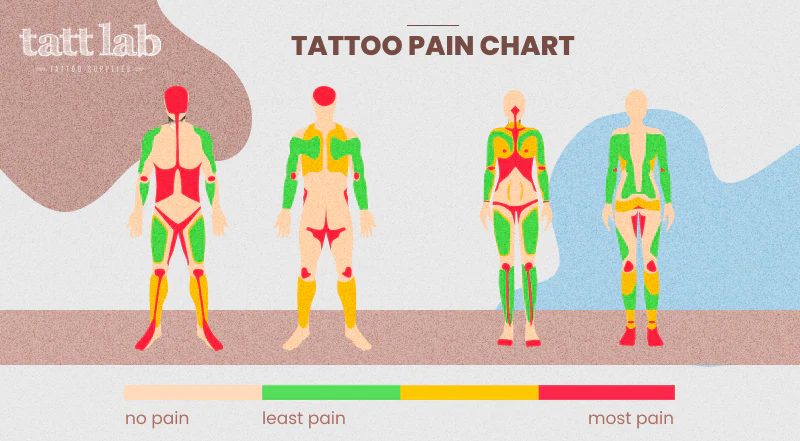
Why Some Tattoo Spots Hurt More Than Others
Pain during tattooing isn’t random—it depends on several physical and psychological factors. Understanding these can help you make an informed choice and set realistic expectations.
Read More: Guide to Tattoo Pain by Body Part
1. Skin Thickness and Fat Cushioning
Areas with thicker skin and more fat or muscle tend to hurt less. The padding absorbs some of the vibration and pressure of the needle, reducing discomfort. Thin skin directly over bone (like the ribs, ankles, or wrists) transmits pain more sharply.
2. Nerve Density
Body parts packed with nerve endings—such as the inner arms, spine, groin, or ribs—are more sensitive. Fewer nerves mean less pain perception, making spots like the outer arms or thighs easier to handle.
3. Bone Proximity
The closer the needle gets to bone, the more intense the sensation. Areas like the collarbone, ankles, knees, or spine are usually more painful for this reason.
4. Artist Technique and Tattoo Style
Pain can vary depending on how heavy-handed your tattoo artist is and the design itself. Shading, color fills, and fine detail work often require multiple passes, which can heighten sensitivity.
5. Individual Pain Tolerance
Everyone’s pain threshold is different. Your stress levels, hydration, sleep, and even mood can influence how you feel pain on tattoo day.
The Least Painful Places to Get a Tattoo
Here are the body areas that most people find the least painful when getting tattooed. These spots are ideal for first-timers or anyone wanting a smoother experience.
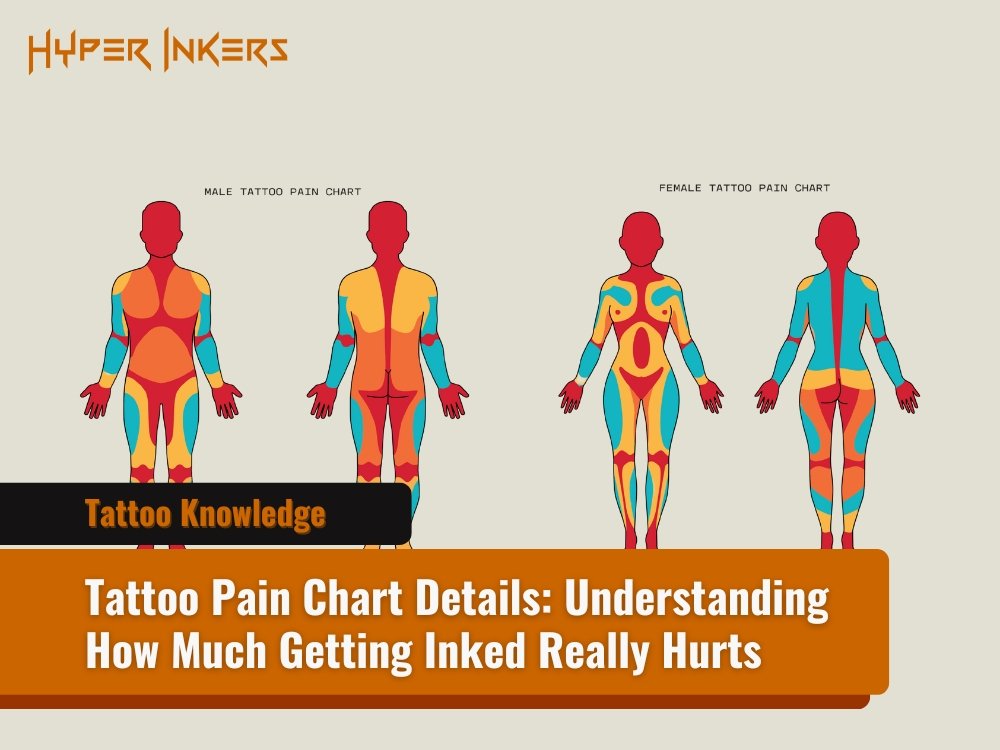
1. Outer Upper Arm (Bicep Area)
The outer part of the upper arm is one of the most popular tattoo placements for a reason. It has thick skin, decent fat and muscle padding, and relatively few nerve endings. Tattoos here heal quickly and are easy to care for.
Pain level: Very mild to moderate
Best for: First tattoos, medium designs, text, or symbols
2. Outer Forearm
The outer forearm is another gentle spot. It’s flat, easy for artists to work on, and the skin isn’t overly thin. You’ll feel vibration and pressure, but it’s usually quite manageable.
Pain level: Mild to moderate
Best for: Minimalist tattoos, quote designs, or geometric pieces
3. Upper Back (Away from Spine)
The upper back has a good balance of muscle and skin thickness, especially away from the spine and shoulder blades. Pain increases closer to the bone, but most central upper-back areas are very tolerable.
Pain level: Mild to moderate
Best for: Larger designs, wings, floral patterns, or back pieces
4. Outer Thigh
Your thighs have some of the thickest, most padded skin on the body. The outer portion, in particular, is comfortable and great for medium-to-large tattoos.
Pain level: Mild
Best for: Portraits, quotes, and creative designs that need space
5. Calves
The calves are muscular and not overloaded with nerve endings, so pain here is usually mild. You’ll feel vibration but not sharp stinging sensations like you would on bonier areas.
Pain level: Mild to moderate
Best for: Detailed linework, nature or animal designs
6. Lower Back (Off the Spine)
The lower back, when tattooed away from the spine, offers a comfortable area with good cushioning. It’s a traditional placement for a reason—manageable pain and flattering results.
Pain level: Moderate
Best for: Decorative or symmetrical designs
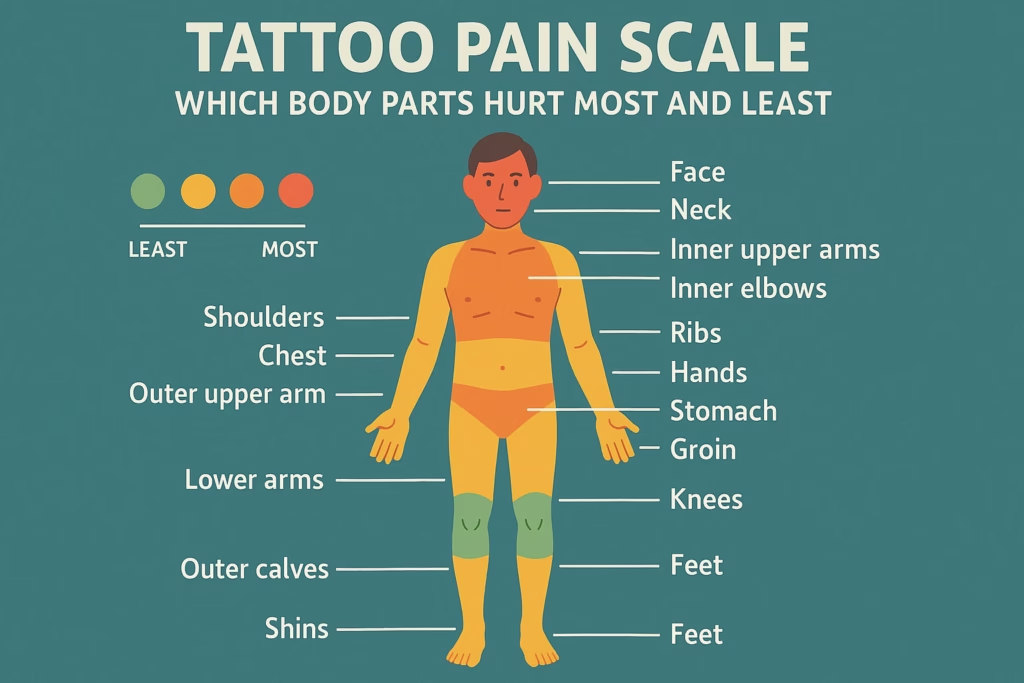
Why “Least Painful” Doesn’t Mean “Pain-Free”
Even in the most comfortable zones, you’ll still feel some degree of discomfort. Tattoo pain is often described as a combination of scratching, stinging, or mild burning sensations. The feeling intensifies slightly as the session goes on or when shading begins.
Longer sessions can make your skin more sensitive, and pain can vary throughout the design. For example, lines may feel sharp while filling feels duller but deeper. Taking breaks helps your body reset and handle sensations more easily.
It’s also normal for tattoos to feel more uncomfortable near joints or areas where the skin stretches frequently. So even within “good” zones, certain parts can still sting a bit more.
Tips to Reduce Tattoo Pain Before and During Your Session
Pain control isn’t just about choosing the right spot—it’s also about preparation and mindset. Here’s how to make your tattoo session as comfortable as possible:
1. Rest and Hydrate
Get a full night’s sleep before your appointment. Fatigue lowers pain tolerance. Drink plenty of water to keep your skin hydrated and resilient.
2. Eat a Balanced Meal
Never go in on an empty stomach. Stable blood sugar levels help prevent dizziness or nausea.
3. Avoid Alcohol and Caffeine
Both thin your blood, which can increase sensitivity and make the tattoo bleed more. Stick to water or juice before your appointment.
4. Consider Numbing Cream (Ask First)
Some topical anesthetic creams can reduce pain, but not all artists allow them. Always ask your artist beforehand so they can approve the product.
5. Bring Distractions
Music, a podcast, or light conversation can make time fly and help your mind focus away from the needle’s buzz.
6. Take Breaks if Needed
Tattoo artists expect clients to need short breaks, especially during long sessions. Don’t hesitate to ask if you’re feeling overwhelmed.
7. Breathe Steadily
Controlled breathing helps relax your muscles and reduces perceived pain. Try slow, steady breaths instead of holding your breath when it stings.
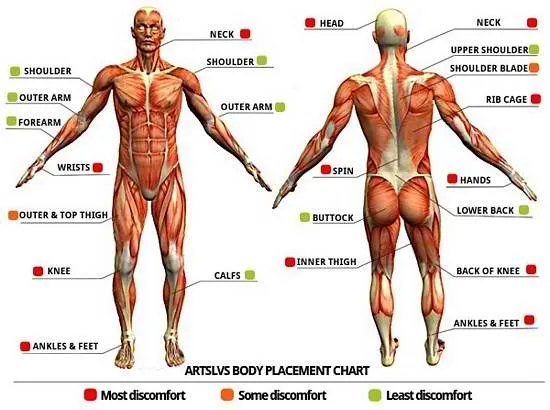
Pain Comparisons: How Different Spots Feel
- Outer arm or thigh: Feels like a light scratch or mild sunburn.
- Forearm or calf: Feels like a buzzing vibration with occasional sharper moments.
- Upper back: Feels like dull pressure or scraping.
- Bony areas (ribs, ankles, spine): Sharp, intense pain that radiates quickly.
- Sensitive zones (inner arms, neck, stomach): Can be quite uncomfortable, even for experienced clients.
These descriptions help you mentally prepare for what to expect. Remember: the pain is temporary, but your tattoo lasts a lifetime.
Healing Comfort and Aftercare Tips
After the tattoo is done, some soreness and tenderness are normal for a few days. Proper aftercare helps minimize discomfort and ensures smooth healing.
- Keep it clean: Gently wash with fragrance-free soap and lukewarm water.
- Moisturize: Apply a thin layer of approved tattoo aftercare cream or unscented lotion.
- Avoid scratching or picking: Let the scabs and flakes fall off naturally.
- Stay out of pools and direct sunlight: These can irritate or fade new ink.
- Wear loose clothing: Avoid friction or tight fabrics that rub against your fresh tattoo.
Most tattoos heal within 2–3 weeks, though complete skin recovery can take a bit longer. Mild soreness or itching is normal—serious redness or swelling means it’s time to check with your artist or a doctor.
Choosing the Best Placement for You
Comfort shouldn’t be your only factor. Think about:
- Visibility: Do you want your tattoo easily seen or easy to cover?
- Design size: Large designs need flat, spacious areas.
- Skin condition: Avoid scarred or highly freckled zones.
- Future plans: Leave space if you might expand the tattoo later.
Most first-timers start with the upper arm or outer forearm because they balance low pain, visibility, and long-term flexibility for adding future designs.
Read More: How to Use Castor Oil in Your Belly Button
Conclusion
While every tattoo involves some pain, knowing where to place it can make a big difference in how comfortable your session feels. The outer upper arm, outer forearm, upper back, outer thigh, calves, and lower back are widely considered the least painful places to get tattooed. These areas have thicker skin, fewer nerve endings, and more natural cushioning.
Still, pain levels vary from person to person. Staying well-rested, hydrated, calm, and communicative with your artist goes a long way toward minimizing discomfort. Preparing mentally and physically will make your tattoo experience far more positive.
Remember, the pain of a tattoo is short-lived, but the art you carry will be with you for life. Choose your spot wisely, focus on aftercare, and embrace the process. Your first tattoo doesn’t have to be painful—it can be empowering, memorable, and beautifully personal.
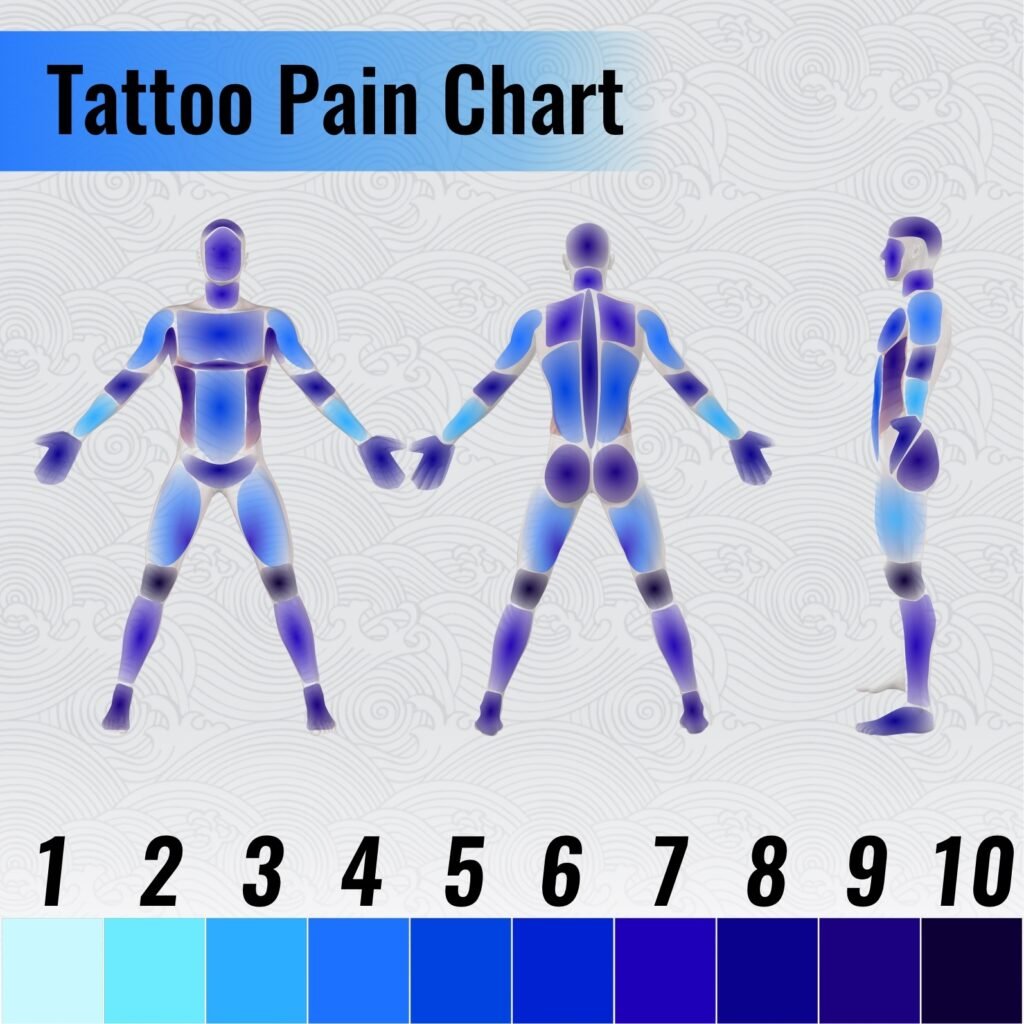
FAQs
Q1. What part of the body hurts the least to get a tattoo?
The outer upper arm, outer thigh, forearm, and calves are typically the least painful because they have thicker skin and fewer nerve endings.
Q2. Is a forearm tattoo painful?
Forearm tattoos are among the most tolerable. You’ll feel some vibration and mild stinging, but it’s far less intense than bony areas like ribs or ankles.
Q3. What’s a good spot for a first tattoo?
For beginners, the upper arm, outer thigh, or outer forearm are ideal. They’re easy to reach, heal quickly, and cause minimal pain.
Q4. Do tattoos hurt more on muscle or bone?
Tattoos on muscles or padded areas hurt less. Over bone, the needle’s vibration and pressure feel sharper and more painful.
Q5. Does size affect tattoo pain?
Yes. Larger tattoos take longer, which can increase discomfort over time. Smaller designs are less painful and a good way to build tolerance.